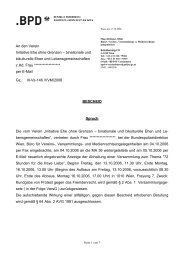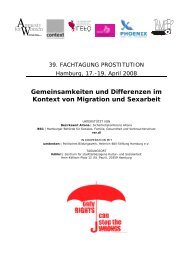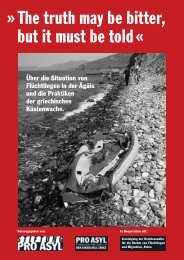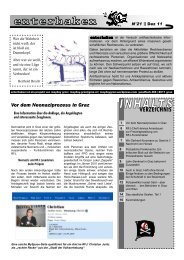Turin's CIE - International University College of Turin
Turin's CIE - International University College of Turin
Turin's CIE - International University College of Turin
You also want an ePaper? Increase the reach of your titles
YUMPU automatically turns print PDFs into web optimized ePapers that Google loves.
administratively entered onto <strong>of</strong>ficial records. This is a striking violation <strong>of</strong> both the letter and<br />
spirit <strong>of</strong> international guarantees for asylum seekers 173 . Even reapplication does not halt<br />
deportation and the overwhelming impression that the <strong>CIE</strong> authorities have about those<br />
applying for asylum is that they are lying: “It is like this because some <strong>of</strong> the stories have nothing<br />
to do with political asylum but sometimes the problem is not with the stories. Sometimes they are<br />
real asylum seekers but they [the <strong>CIE</strong> authorities] do not understand, they think that they<br />
[detainees] are all liars. They are all treated like liars” (Interview 8).<br />
Moreover, there is anecdotal evidence to suggest a racial and national classification <strong>of</strong> irregular<br />
entrants and migrants, which violates the fundamental principle against a group-identity based<br />
denial <strong>of</strong> asylum claims. The theory and the practice <strong>of</strong> claiming asylum is starkly different:<br />
81 | P a g e<br />
“It works like this when you arrive in Lampedusa: if you are Black they make you apply for<br />
asylum, if you are Arab they take you to <strong>CIE</strong>. In recent years there has been a true racial<br />
separation. From the theoretical point <strong>of</strong> view, according to the law if you apply for asylum<br />
at the border you will be taken to CARA [reception centre for asylum seekers], while if you<br />
do not apply for asylum and you are issued a rejection order or a return decision you will<br />
be taken to <strong>CIE</strong>. If you apply for asylum after you received a rejection order or return<br />
decision, that is after you entered <strong>CIE</strong>, then you have to stay inside <strong>CIE</strong> until a decision is<br />
made by the relevant Commission. Meanwhile your removal is suspended.<br />
But from the practical point <strong>of</strong> view it works in a different way. In 2011, 25,000 Tunisian<br />
migrants arrived in Italy and in addition there were migrants from sub-Saharan Africa.<br />
When boats were coming from Libya it was decided that those people could apply for<br />
political asylum. On those boats there were people from Nigeria and from Mali who had<br />
never thought about Italy, they were fleeing a war and they did not even know what an<br />
application for asylum was. The UNHCR was responsible for dividing those who could<br />
apply from those who could not. If on the same boats there was a Tunisian guy, given the<br />
fact that there is a well-working repatriation agreement between Italy and Tunisia, he was<br />
directly taken to <strong>CIE</strong>. Arab people were not allowed to apply for asylum. If they wanted to,<br />
they could do it from inside <strong>CIE</strong>.<br />
[…] So, there are people who are arbitrarily directed towards the asylum procedure, when<br />
such procedure will end up in a refusal. There has been a certain approximation in dealing<br />
with these procedures. There have been serious cases in 2011. There have been Tunisian<br />
migrants who applied for political asylum the moment they crossed the border. The<br />
UNHCR did its job properly but then the Prefettura <strong>of</strong> Lampedusa did not formalise the<br />
application. And this is a very serious episode” (Interview 28).<br />
Another case which calls into question the way that asylum procedure is conducted is a recent<br />
experience that a lawyer recounted whereby owing to administrative lachesse an asylum claim<br />
almost failed to be heard. The manner in which the whole incident occurred suggests endemic<br />
problems with the way the Italian asylum system is operating:<br />
On 28 April 2012, “Y” was brought to <strong>Turin</strong>’s <strong>CIE</strong> after receiving a deportation order. Y is a<br />
Nigerian citizen who fled from Kaduna’s riots in 2002 and whose immediate application for<br />
asylum had been rejected. On 30 April 2012, <strong>Turin</strong>’s Giudice di Pace validated Y’s detention and<br />
173 “Also, for example, if I am inside the <strong>CIE</strong> and I ask the Red Cross to make a request for political asylum,<br />
from the moment I make this request to the moment they bring me to the Immigration Office inside the camp to<br />
formalise the request, one week, ten days, two weeks can pass. During this week I have no guarantee and I can<br />
be deported. You are not protected until you formalise your request. If there is a lawyer who comes and says,<br />
well, there is my client who wants to ask for it [asylum], okay, they will write [it] in the Immigration Office but<br />
if there is no lawyer then there is no guarantee” (Interview 7).















